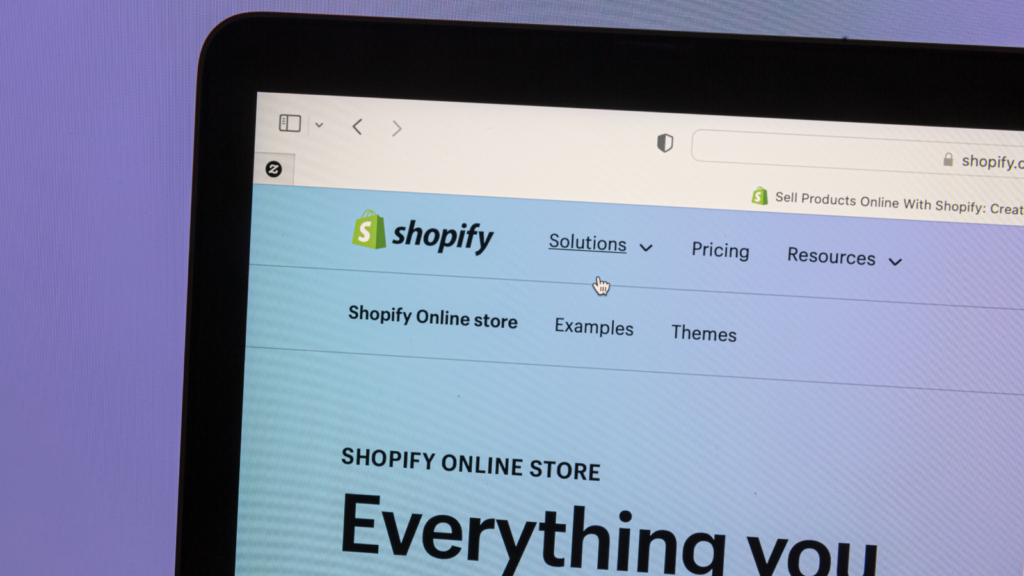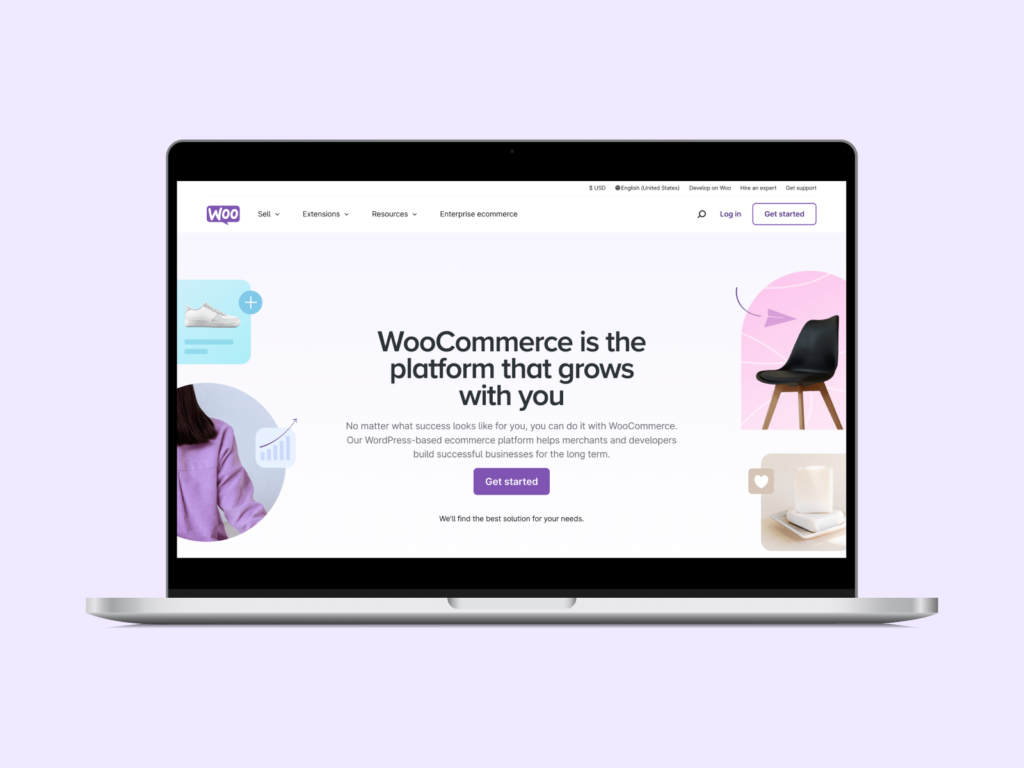Sell custom products with Printify
Shopify is a powerful cloud-based eCommerce platform that enables businesses and individuals to easily create and manage online stores. Known for its flexibility and comprehensive sales management tools, Shopify is a popular choice for entrepreneurs and established brands alike.
But is Shopify worth it for your retail needs? Let’s explore what to look out for, how Shopify benefits merchants, and how it compares to other eCommerce platforms.
Key takeaways
- Shopify’s diverse pricing plans cater to brands of all sizes, offering everything from affordable starter options to advanced plans with lower transaction fees and enhanced features.
- Shopify excels in scalability and multichannel sales, making it ideal for businesses aiming to grow and expand globally.
- Its vast app store and integrations allow store owners to customize features like SEO, marketing, and inventory management depending on their needs.
- Compared to other platforms, Shopify offers the most diverse list of integrated eCommerce tools, including POS systems and advanced payment solutions.
- Some platforms outperform Shopify in content management and customization flexibility, with less reliance on third-party apps.
Shopify, an overview
Shopify is an all-in-one eCommerce platform known for its user-friendly interface and powerful functionality. It offers tools for everything from order management to marketing, making it a versatile choice for businesses of all sizes.
One of Shopify’s standout strengths is its flexibility. Whether you want a simple online store or an advanced solution with multiple sales channels, Shopify offers plans for varying needs.
Shopify pricing plans
The platform’s subscription funnel guides potential sellers through a free trial phase, followed by the Shopify Starter plan to experiment with the platform, and finally, the Basic Shopify plan for independent merchants or the Advanced Shopify plan for larger enterprises.
| Plan | Pricing (Monthly) | Pricing (Annual) | Transaction fees |
|---|---|---|---|
| Starter | $5/month | – | 5% + $0.30 per online transaction |
| Basic | $39/month | $29/month | 2.9% + $0.30 per online transaction |
| Retail | $89/month | $79/month | 2.9% + $0.30 per online transaction |
| Shopify | $105/month | $79/month | 2.6% + $0.30 per online transaction |
| Advanced | $399/month | $299/month | 2.4% + $0.30 per online transaction |
| Shopify Plus | Starting at $2,300/month | – | The lowest fees, varies by country |
For more details, check our Shopify pricing guide.
Pros of using Shopify

1. User-friendly interface
Shopify’s interface simplifies setting up and managing an eCommerce site, accommodating users of all levels.
- Drag-and-drop editor for easy customization of your store’s layout, branding, and functionality.
- Dashboard for adding product inventory, managing orders, and reviewing analytics.
- Suitable for beginners and advanced Shopify users alike.
2. App Store integration
The Shopify App Store holds a catalog of tools that enhance business functionality, providing marketing, inventory management, and customer engagement solutions. These integrations help address business needs for growth, adaptation, and automation.
- Thousands of apps for SEO, email marketing, and UX upgrades.
- Free and premium themes from the Shopify Theme Store for visual customization.
- Tools like abandoned cart recovery or Shopify Magic to generate listings.
3. Multichannel and global sales options
Shopify supports selling across multiple platforms and markets, helping merchants expand globally. With Shopify Markets, sellers can localize their stores for different customer demographics, while the Shopify POS (point of sale) system bridges payment processing operations.
- Sell on Facebook, Instagram, Amazon, and Google Shopping.
- Global storefronts with multi-language and multi-currency capabilities.
- Shopify POS integrates online and offline sales.
4. Secure and reliable hosting
Shopify provides reliable and secure hosting, freeing merchants from the need to manage the technical aspects of website maintenance. Its infrastructure guarantees fast website performance and data security, even during peak traffic periods for larger enterprises.
- Built-in SSL certificates and PCI compliance for secure transactions.
- Fast load times and reliable server performance with high uptime.
- Shopify Sales Tax automatically applies applicable taxes to your sales.
5. Scalable and flexible platform
Shopify adapts to the needs of growing businesses, providing tools and plans to support merchants at every stage. As businesses expand, Shopify apps offer automation and advanced solutions for scaling operations.
- Scalable plans from Basic Shopify to Advanced Shopify for better transaction fees.
- Advanced tools for inventory management, marketing, and automation.
- Flexibility to evolve with changing customer behavior and market trends.
Cons of using Shopify

1. High costs and fees
Shopify’s pricing structure can be costly for smaller businesses or startups, especially when factoring in additional fees and paid apps. Businesses using third-party payment gateways, instead of Shopify Payments, can also incur extra charges, further raising costs.
- Transaction fees for external payment gateways.
- Paid apps increase monthly costs as features are added.
- Entry-level plans like Basic Shopify lack advanced features.
2. Reliance on apps for advanced features
While Shopify covers basic eCommerce needs, it relies on apps for advanced capabilities. This dependency can complicate operations and inflate costs for businesses requiring extensive features.
- No built-in options for product bundling or subscription management.
- Advanced analytics and reporting require third-party integrations.
- Reliance on apps increases operational complexity.
3. Customization challenges
Advanced customization often requires technical expertise or hiring developers, which can strain budgets for smaller businesses. Shopify themes are adaptable, but merchants need to know coding languages like HTML, CSS, or Liquid for unique designs.
- Coding knowledge needed for advanced Shopify site customization.
- Dependence on developers for unique features increases expenses.
- Limited flexibility for businesses without technical resources.
4. Limited content tools
Shopify’s blogging and content features aren’t as robust as those of platforms like WordPress or Squarespace. This limitation makes it difficult for merchants focused on content marketing to fully optimize their stores for SEO and branding efforts.
- Basic blogging tools lack advanced formatting and SEO capabilities.
- Limited support for visually rich, long-form content.
- Merchants may need external tools for effective content creation.
5. Learning curve for advanced features
Although Shopify is easy for beginners to use, merchants need to invest time in mastering advanced tools and integrations. The lack of detailed tutorials for certain features adds to the challenge, especially for first-time eCommerce users.
- Advanced tools like Shopify SEO and POS require additional learning.
- Limited or third-party guides for complex features slow down progress.
- Time investment needed for merchants new to eCommerce platforms.
Shopify vs other eCommerce platforms
Choosing the right eCommerce platform is one of the biggest decisions when starting or scaling an online store. So, is a Shopify store worth it? Shopify is a leading option, but it’s worth comparing it with other top eCommerce alternatives before making a final decision.
Shopify vs Wix

Wix, compared to Shopify, excels with its beginner-friendly drag-and-drop builder. Its intuitive interface ranks close among the best retail hosting platforms for eCommerce newcomers.
Shopify’s App Store offers a broader range of tools for businesses with complex needs, such as multi-channel marketing and advanced analytics, while Wix’s app marketplace caters more to straightforward setups – essential integrations for SEO, email marketing, and social media.
Both platforms support growth, but Shopify excels with its variety of apps for functionality as business demands evolve, even if these customization options require more technical skills.
Features and customization:
- eCommerce tools: Shopify provides specialized tools for inventory management, order analytics, and marketing, making it ideal for scaling an online store. Wix lacks some advanced eCommerce functionalities like inventory tracking or in-depth sales analytics.
- Customization: Wix shines with its drag-and-drop website builder and visual flexibility, enabling creative designs. Shopify, while less flexible visually, provides customizable templates optimized for driving sales and improving conversion rates.
- Third-party apps: Shopify’s app store is extensive, with thousands of integrations for SEO, marketing, and analytics. Wix has a smaller app marketplace, which offers similar tools but limits options for advanced app customization, automation, and scalability.
Pricing:
Wix has a $36/month Business plan, while Shopify’s equivalent plans start at $39/month. Wix appeals to small businesses, but Shopify’s scalability with higher-tier plans that reduce even more friction suits eCommerce needs for fast-growing online businesses.
Shopify vs Squarespace

Squarespace is celebrated for its elegant templates and straightforward design tools, making it a strong contender for businesses prioritizing content-driven strategies. Its visual design capabilities and focus on aesthetics provide an edge for creators and service-based businesses.
Shopify, compared to Squarespace, stands out for its powerful eCommerce features, designed for scalability and optimized for store owners focused on selling products. While Squarespace supports selling online, its features cater more to small-scale operations and branding.
Both platforms offer user-friendly interfaces, but the choice depends on whether content or commerce takes priority in your business model, as Shopify is primarily a sales-focused platform.
Features and customization:
- Templates: Squarespace offers sleek, visually rich templates ideal for branding, while Shopify focuses on functional, sales-driven themes optimized for mobile and speed.
- Content tools: Squarespace excels in blogging and content marketing, whereas Shopify provides robust eCommerce features like POS and product management.
- Integration: Shopify offers extensive third-party app integrations for inventory, marketing, and shipping, making it better for scaling, while Squarespace suits content-focused brands.
Pricing:
Squarespace plans start at $16/month for basic sites, with Business and Commerce plans ($23-$99/month) adding more eCommerce capabilities. Shopify’s business-level plan starts at $39/month, demonstrating that Squarespace can offer more flexibility depending on business needs.
Shopify vs WooCommerce

WooCommerce is a powerful WordPress plugin that transforms websites into fully functional online stores. Similar to Squarespace, it’s a flexible option for content-driven businesses and offers unmatched customization, especially for those familiar with WordPress.
Both WooCommerce and Shopify cater to store owners of all sizes, but their approaches differ significantly. WooCommerce relies on WordPress, requiring users to handle hosting, updates, and security, which offers freedom but adds complexity. Shopify centralizes these aspects, making it a great option for those who prefer ease of use and faster store deployment.
Features and customization:
- Flexibility: WooCommerce allows unlimited customization through plugins but requires technical skills, while Shopify’s built-in tools streamline setup.
- Scalability: Shopify simplifies growth with built-in multi-channel support, whereas WooCommerce relies on extensions, which can cause compatibility issues.
- Themes: WooCommerce themes demand manual setup, while Shopify’s templates are user-friendly and optimized for sales but less flexible.
Pricing:
WooCommerce is free to install but comes with additional costs for hosting, domain registration, and premium plugins. However, creating an established business with WooCommerce under the $39/month Shopify markup is more than possible.
Shopify vs BigCommerce

BigCommerce is a comprehensive eCommerce solution designed to support larger businesses with an omnichannel focus. It emphasizes built-in functionality and caters to merchants who prefer having advanced tools included as a baseline without needing extensive third-party apps.
By contrast, Shopify offers a flexible platform with a large app ecosystem, ideal for businesses that want to customize their store’s functionality as they grow, adapting to new technologies.
BigCommerce emphasizes its strong native features, providing merchants with a seamless, out-of-the-box experience for managing inventory, running marketing campaigns, and optimizing SEO, which can be a convincing option for those who need a one-and-done solution.
Features and customization:
- Product management: BigCommerce handles large catalogs with bulk editing, while Shopify’s intuitive dashboard simplifies inventory and order tracking.
- Apps: BigCommerce reduces app reliance with native SEO and multi-channel tools, while Shopify’s app ecosystem offers greater variety but higher dependency.
- Customization: Shopify themes are straightforward and sales-focused, while BigCommerce offers deeper customization for larger operations and omnichannel strategies.
Pricing:
BigCommerce plans start at $29/month, and there are no transaction fees, making it highly cost-effective for large-volume sellers. However, when sales exceed specific annual thresholds, it automatically upgrades merchants to higher-tier plans, which could unexpectedly increase costs.
Shopify and Printify – Start an online business with ease

Is starting a Shopify store worth it? Absolutely. Shopify stands out as one of the leading eCommerce platforms, and when paired with Printify, it offers a seamless solution for launching and managing a profitable online store with custom-printed products. Design, connect, and sell through a Shopify store with a no-inventory, print-on-demand approach.
Here’s how to get started:
1. Sign up
Create a Printify account for free. Access our wide range of products, experiment with designs, and overview our network of Print Providers and fulfillment centers to supply your product needs.
2. Choose your products
Browse Printify’s Catalog of customizable items for Shopify clothing stores and more. Select products that align with your niche and cater to your target customer behavior.
3. Apply the designs
Use Printify’s drag-and-drop Product Creator to upload your designs and tailor products with unique colors, text, and images. Whether you want to use pre-made designs or start from scratch, you can easily create products and create quality mockups that resonate with buyers.
4. Integrate with Shopify
Connect Shopify with our Printify integration to store your designs and publish listings.
Here’s how to set up product listings:
- Log in to your Shopify admin panel and visit Shopify’s App Store.
- Search for Printify in the Shopify store marketplace.
- Click Add App, follow the prompts, and authorize the connection between Printify and Shopify.
- Once connected, sync your designed products from Printify to Shopify by clicking Publish to Store within the Printify app.
5. Sell, sell, sell
Use Shopify’s website builder and free Shopify themes to design an attractive storefront. After setting up your Shopify store, go live! Check successful Shopify stores and unique store examples from merchants of all backgrounds to update your marketing and selling strategy.
FAQ
Yes, selling on Shopify is worth it, especially for businesses prioritizing eCommerce. Each Shopify plan caters to different business sizes, offering scalability and essential tools like inventory management, Shopify Payments, marketing integrations, and customization options.
Since you can start with a free trial to explore features before committing to a plan, Shopify is worth it for a small business that needs the initial experience without initial investment.
Yes, thousands of merchants run profitable stores, easily covering their Shopify costs through sales and growth. Success depends on your ability to choose the right niche, optimize your store for conversions, and use advanced eCommerce tools in the Shopify app store for automation, marketing, and analytics.
Transaction fees vary by plan. With Basic Shopify, it takes 2.9% + $0.30 per transaction, which equals $3.20 on a $100 sale. Upgrading to advanced plans lowers this percentage, making Shopify more cost-efficient as your store grows in sales volume.
Additional fees may apply for credit card processing or third-party payment gateways.
The reliance on third-party apps for advanced features can increase operating costs. Shopify also lacks robust content marketing tools, making it less ideal for content-heavy sites. The Shopify platform has a learning curve for tools like Shopify SEO or advanced sales tax settings. While it excels in eCommerce, these cons of Shopify can be challenging for some store owners.
So, is Shopify worth it?
Shopify is one of the best eCommerce platforms, offering a centralized payment system, scalable plans, and robust customer support resources. While its cost and reliance on apps may not suit every business, it’s a versatile option for online stores with powerful integrations.
Our detailed Shopify review highlighted what makes Shopify work, the features and customization options available, and how it compares to other platforms.












